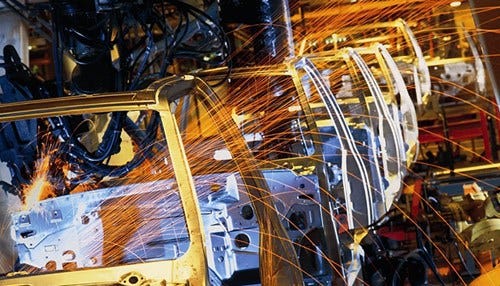Industry Leads Changes in High School Manufacturing Classes
 The report shows automotive-related manufacturing accounts for the largest share of advanced industries jobs in Indiana.
The report shows automotive-related manufacturing accounts for the largest share of advanced industries jobs in Indiana.
Subscriber Benefit
As a subscriber you can listen to articles at work, in the car, or while you work out. Subscribe NowAs close as possible to authoring the textbooks, manufacturers are hopeful their involvement in creating Indiana’s curriculum for manufacturing classes will grow a crop of students to help fill a skills gap in the state. After an earlier update in 2014, students are now learning from refreshed curriculum created in 2016.
Standards were refreshed this year and are being used to inform the statewide coursework that is developed by the Career and Technical Education (CTE) branch of the Indiana Department of Education. While Indiana Superintendent of Public Instruction Glenda Ritz says CTE regularly works with industry to tweak its curriculum, fresh funding and insights from industry panel discussions held throughout the state earlier this year enhanced its efforts.
“[The state] received a grant to support expansion of college and career pathways for students, aimed at directly relating the pathways to the needs of Indiana industry,” says Ritz. “When we build pathways and course sequences, we begin with the end in mind; course standards are designed so students are prepared for the industry. It wouldn’t be possible to do that without industry involvement as the standards are developed.”
Leaders at Indianapolis-based Allison Transmission were part of the industry team, assembled and facilitated by Conexus Indiana, that provided input to update the statewide manufacturing course standards. Allison Director of Education and Development Bill Turner says the company saw it as an opportunity to help create a pipeline of future workers who “have a baseline-level understanding of manufacturing.”
In its suggestions to Conexus Indiana, the company focused on the skills an ideal entry-level production worker would need: knowledge about operating CNC machines, problem-solving capabilities, basic math and some industrial math skills, and “soft-skills,” like communication and self-motivation.
“We have a wave coming up where we could have several hundred people retire, because they have the time in; that’s a lot of knowledge that could walk out the door,” says Turner. “If you have a pool of people to hire from who have never had any manufacturing experience, now we’re starting from ground zero. We have to bring them up to at least a basic knowledge of manufacturing, and then take them to where we need them on the floor at Allison.”
Ritz says the 2016 update has evolved from previous versions, with a heavier emphasis on higher-level skills, exposure to technology and employability skills. She notes the curriculum is also more closely aligned with guidelines created by the Manufacturing Skills Standards Council, a national system for training and certification for production and material handling workers.
Ritz also noted the statewide manufacturing CTE courses are funded at the highest level; support ranges from $150 to $500 per student, per credit hour. Each CTE program is funded on a sliding scale based on the state’s labor market and wage level. Ritz says, because manufacturing is a high-wage, high-demand sector, school systems receive $500 per student.
“[The state] builds the standards, but the student engagement and meeting with industry must happen, in reality, at the local level,” says Ritz. “The optimum is a really close partnership between local industry and the schools.”
Turner says that’s where he sees the most momentum. He believes the state has made significant progress in bringing industry and educators together to focus on tomorrow’s work force.
“There aren’t enough [workers] in the pool, because it’s not just Allison pulling from it; it’s Rolls-Royce, Cummins and all of the smaller companies. We have to keep building that pool,” says Turner. “And keep marketing the fact that you don’t have to go to a four-year college to have a good career. There are great careers out there with certifications or an associate’s degree as the ticket in.”
In the CTE world, that career path starts in high school, with a curriculum that reflects the changing needs of an industry hungry for well-prepared workers.
Turner says Indiana is gaining momentum in the effort to bring together industry and educators to focus on tomorrow’s work force.
Ritz says keeping course standards aligned with the changing needs of industry is a never-ending process.
